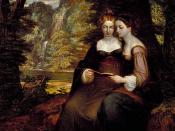In A Midsummer Night's Dream by William Shakespeare, the theme of love's elusiveness is clearly portrayed. It becomes apparent that the four lovers in the story are not in control of their love and furthermore that their love is insincere. Evidently, this is because of the mischief that Robin Goodfellow brings to the characters with a magic cowslip flower. The love that Lysander has for Helena is false, as is the love that Demetrius has for Helena, and Titania for Bottom.
If we look more closely at the relationship between Titania and Bottom, it becomes particularly obvious that their love is false. Titania, the queen of the fairies, wouldn't (in her right mind) fall in love with such a vile creature as Bottom. "Come, sit thee down upon this flow'ry bed, while I thy amiable cheeks do coy, and stick muskroses in thy sleek smooth head, and kiss thy fair large ears, my gentle joy."
(4.1.1/4) At the time, Bottom had even taken on the appearance of an "ass." The romance that Titania and Bottom share for a short time is out of their grasp. Why would the queen of fairies want to be associated with an "Ass-head"? The answer comes back to the everlasting theme that love is elusive.
Another example of love's elusive nature is the deceptive relationship between Lysander and Helena at the end of the story. Once again, Robin makes mischief with the cowslip. This time he puts it over Lysander's eyes, who then awakes with a false love for Helena. Lysander, who happens at the time to be engaged in affairs with Hermia, inexplicably puts all of that behind him. Lysander says to Helena, "Content with Hermia? No, I do repent the tedious minutes I with her have spent. Not...


